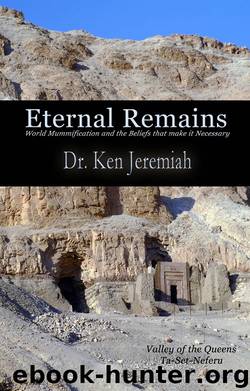Eternal Remains: World Mummification and the Beliefs that make it Necessary by Jeremiah Ken

Author:Jeremiah, Ken
Format: epub
Publisher: First Edition Design Publishing, Inc.
Published: 2014-01-14T05:00:00+00:00
33. Depiction of Osiris, from the tomb of Horemheb, Egypt. He is on the left, wearing a tall crown that the Roman Catholic Church later adopted as a symbol of power, the miter.
At the ceremony of Osiris, attendees reenacted his death and resurrection. They looked for his body parts, until eventually the head priest declared, “Osiris has been found.” Ceremony leaders placed the symbolic body into a vessel, and believers followed behind as it was taken to a tomb. Once the funerary procession reached the symbolic resting place, attendees said prayers to initiate his resurrection. Leaving the body as it was, for three days believers mourned for their god and said prayers for him, until he was resurrected. On the day of his resurrection, the priests having removed his body to symbolize the god’s actual resurrection and disappearance, they erected the Pillar of Osiris in front of the temple, and displayed a picture of the bearded god. This rite was so important to the ancient Egyptians that it continued to be celebrated for thousands of years. It was even practiced during the Roman period, and it had a strong influence on other developing faiths.
Due to Osiris’s connection with motifs of death, mummification, and resurrection, he played a prominent symbolic role in ceremonies conducted after Egyptian citizens’ deaths. He became the Judge of the Dead. The dead were thought to pass through a Hall of Judgment before proceeding to either Heaven or Hell. Osiris was present at this trial. If the deceased was going to triumph over death, he had to become completely identified with Osiris. Everything done to Osiris’s body must also be done to his own body. He was therefore given the name Osiris in texts inscribed upon his funerary papyrus and tomb items, which would guide him through the trials of the afterlife. His body was also embalmed in the same manner as Osiris. The procedure included the removal of internal organs and covering the body in natron for many days, which resulted in the body’s desiccation. Finally, preparers covered the remains in fine linen. Alan Shorter (1983) wrote:
Download
This site does not store any files on its server. We only index and link to content provided by other sites. Please contact the content providers to delete copyright contents if any and email us, we'll remove relevant links or contents immediately.
| Africa | Americas |
| Arctic & Antarctica | Asia |
| Australia & Oceania | Europe |
| Middle East | Russia |
| United States | World |
| Ancient Civilizations | Military |
| Historical Study & Educational Resources |
The Daily Stoic by Holiday Ryan & Hanselman Stephen(3206)
The Fate of Rome: Climate, Disease, and the End of an Empire (The Princeton History of the Ancient World) by Kyle Harper(2984)
People of the Earth: An Introduction to World Prehistory by Dr. Brian Fagan & Nadia Durrani(2680)
Ancient Worlds by Michael Scott(2600)
Babylon's Ark by Lawrence Anthony(2506)
The Daily Stoic by Ryan Holiday & Stephen Hanselman(2433)
Foreign Devils on the Silk Road: The Search for the Lost Treasures of Central Asia by Peter Hopkirk(2414)
India's Ancient Past by R.S. Sharma(2377)
MOSES THE EGYPTIAN by Jan Assmann(2354)
The Complete Dead Sea Scrolls in English (7th Edition) (Penguin Classics) by Geza Vermes(2212)
Lost Technologies of Ancient Egypt by Christopher Dunn(2181)
The Earth Chronicles Handbook by Zecharia Sitchin(2160)
24 Hours in Ancient Rome by Philip Matyszak(2034)
Alexander the Great by Philip Freeman(2017)
Aztec by Gary Jennings(1941)
The Nine Waves of Creation by Carl Johan Calleman(1852)
Curse Tablets and Binding Spells from the Ancient World by Gager John G.;(1825)
Before Atlantis by Frank Joseph(1793)
Earthmare: The Lost Book of Wars by Cergat(1770)
